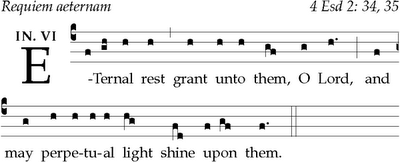This afternoon I had a two-hour video and screen-sharing Skype session with Fr. Columba Kelly OSB, Gregorian chant master and prolific English chant composer. We reviewed, discussed, and worked through all of the “mode 1” Introit antiphons that I have set for the Simple English Propers collection. These antiphons all employ the same “melodic formula” or melodic model which is applied and adapted uniquely to all of the introit texts of the Gregorian Missal which employ (in their Gregorian setting) the first mode. If you sing through a few of these antiphons you will quickly see that they are all based on the same melodic model. The purpose of this is to make the singing of new Introit, Offertory and Communion propers every week an attainable reality for parish singers.
Click here to download the complete cycle of mode 1 Introits that will be found in the Simple English Propers collection.
In total, there will be 24 melodic formulas that are employed in the Simple Propers book (actually 23 since there are no mode 7 Offertories found in the Gregorian Missal). There are 8 unique melodic models, one in each mode, designated for each proper genre: Introit, Offertory and Communion. There are certain features that are retained in each genre in order to give the genre some kind of uniqueness as such, although the scope here is rather limited based upon the chosen parameters and limitations of the project.
I have to say that crafting these melodic formulas is one of the most difficult compositional challenges I have ever attempted. It is much like writing a canon or a fugue. The difficult lies in anticipating the textual varieties in the English language and assuring that the melody will work with virtually any text that the English language can produce. Word accent patterns in English intonations and terminations are extremely varied, with an alarmingly greater variety than the Latin language, and the threat of back-to-back monosyllabic (oxytonic) word accents is ever present in English texts (e.g. to Yóu, Lórd Gód) and must be taken into consideration when crafting melodic models. Of course, word accent is treated very particularly in the authentic Gregorian chants and this attention to the delicacy of the text is one of the notable features of the Gregorian repertory. The esteemed Fr. Columba Kelly has spent a lifetime studying this relationship between text and melody that is found in Gregorian chant, and has demonstrated a mastery of applying the genius of the Gregorian idiom to English texts. I am very blessed to have had him as a teacher, and am overjoyed that he is overseeing my efforts in producing the Simple English Propers collection. Because of his review of my work I am confident that a collection of simple English chants will come to be that are obedient to the nature of Gregorian chant, and at the same time are able to be sung well by nearly everyone.
In a perfect world I would like focus on crafting the antiphons that will be used in the Simple English Propers before any further work in producing complete scores is done, but I realize that there are many who are relying on having a weekly offering available for immediate use in liturgy, and I will guarantee that you will have simple propers to sing for every Sunday and Feast from here on out. What this means, though, is that what is posted is still in development, since if one change is made to a melodic formula it will necessarily affect the entire lot! I do have all of the melodic formulas for this project crafted, though, and I have a strong sense that they will all pan out nicely in the end. You never know when the chant master will lay the smacketh-down, however, so changes may be made to posted antiphons until the entire cycle has stabilized.
In any event, I hope that you will give this cycle of mode 1 Introits a sing, and I hope that you will see the benefit that they may present typical parish choirs and cantors. I can tell you that they have been an absolute God-send for my own parish music program, who only began the project of introducing propers into parish liturgy a short year and a half ago. The variety among familiarity seems to be in just the right balance. I certainly hope that this will prove to be the case for all who sing them.
In closing, thank you to all who have supported this project, especially those who have made a financial contribution. I thank you all very sincerely for your generosity and for your giving a go this new and exciting model of sacred music commissioning, production and distribution!


